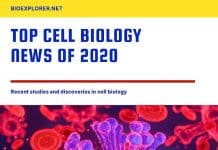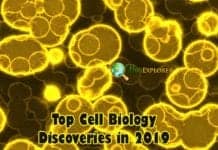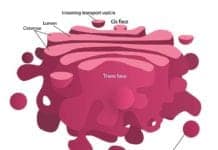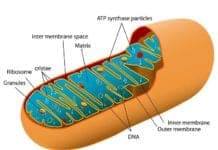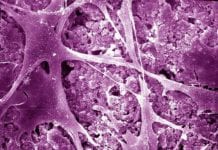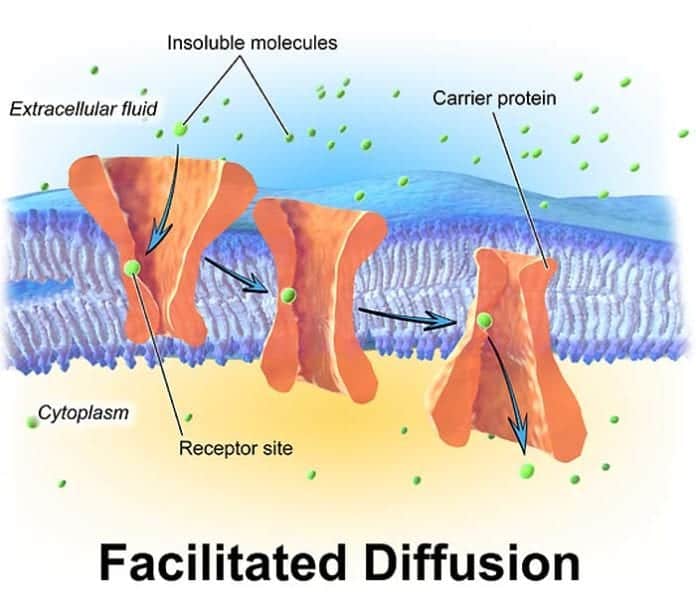
Facilitated Diffusion: Imagine the situation in a crowded entrance of a concert hall or arena. Before the concert, everyone seems to want to enter the place as soon as possible. The lines are too long, the place is too jam-packed, and fans may be standing so close to each other. However, as the door opens, fans quickly enter, and the previous crowd started to spread out.
This scene is quite similar in the case of diffusion of molecules and substances. By definition, diffusion refers to the physical movement of molecules to free space as a result of the kinetic properties found in al molecules.
Diffusion, which comes from the Latin word “diffundere” (meaning “spread out“), may also be defined as the movement of molecules down a concentration gradient as they will have to mix in order to be evenly distributed.
Diffusion is considered to be a spontaneous process; however, this is not always the case; some molecules and substances need assistance in order to permeate membranes–such process is known as facilitated diffusion.
The understanding of such a process is essential to the basic knowledge of how cells work, and primarily, how living organisms survive. However, one crucial thing is that most membranes of living organisms are impermeable to hydrophilic (water-loving) molecules.
This becomes a dilemma because most essential molecules are as such. With the use facilitated diffusion, this problem is easily solved by cells.
Find out how as you learn more about this process below.
Table of Contents
What is Facilitated Diffusion?
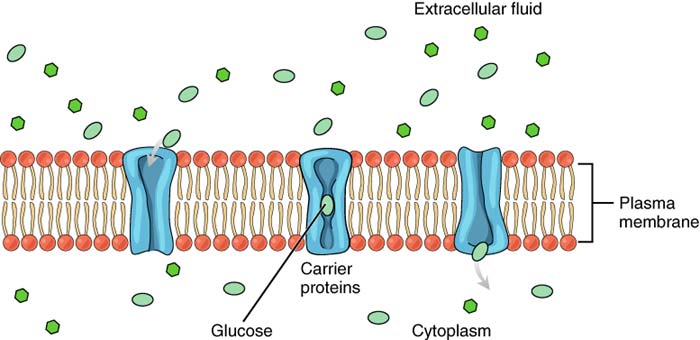
In living organisms, the diffusion of substances is mediated by the cell membrane. By definition, facilitated diffusion is a type of passive transport which utilizes “agents” known as channel proteins and carrier proteins to speed up the transport process. While there are some proteins found in the cell membrane, only the said types of proteins play a significant role in facilitated diffusion.
- Channel proteins facilitate the entry and exit of substances in the cell. Two types of channel proteins exist–open and gated channel proteins. On the one hand, open channels are transmembrane proteins that create a pore in the cell membrane, thus permitting charged molecules to pass through. On the other hand, gated channel proteins work like channels that either closed or open to regulate the entry of substances. After the process, the proteins revert to their previous positions.
- For instance, carrier proteins, which are embedded in the cell membrane, change the conformation of the substances to be transported and then release them to the other side of the membrane. Carriers with high rates of associations and dissociations are very efficient in executing the process. Carrier proteins are affected by various external factors like temperature and saturation. There are a limited number of such transporter agents which sometimes “max-out” at a rate of transport. Aside from that, for a transport process to occur, a configuration change is highly significant.
- Unlike free diffusion of molecules, facilitated diffusion strongly relies on the binding of substances with channel and carrier proteins. Also, the rate of saturation during free diffusion is relatively slower than that of facilitated diffusion, which slows down when a “saturation point” is reached. Temperature also matters since facilitated transport occurs when it is mild. Its dependence on temperature is because of the presence of an activated binding.
- However, not all substances can freely pass through the cell membrane. Facilitated diffusion is selective because the agents above can reversibly work with high permeability and selectivity.
- In order to be selective, the membrane allows certain substances like ions and molecules to pass through it, while it prevents other substances like the carrier molecule itself.
- Chemical conditions like electric charge and pH make it possible for the diffusion across membranes.
![]()
Facilitated Diffusion Experiments
Interestingly, several attempts have been made by scientists and engineers to imitate the process of facilitated transport in non-biological membranes. Such efforts were primarily made as a mechanistic basis of industrial-scale liquid and gas separations.
However, at present, there has been no reported successful attempt yet, mostly associated with the poor dissociation and overall rigidity of the carrier proteins used.
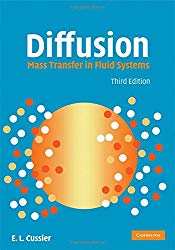 According to the calculations and experiments were done by Cussler and his colleagues (1988), facilitated diffusion can happen in polymer membranes as long as they have “chained” carriers bound to them.
According to the calculations and experiments were done by Cussler and his colleagues (1988), facilitated diffusion can happen in polymer membranes as long as they have “chained” carriers bound to them.
Their results show that membranes with the said carriers will display many similarities to that of the membranes with bound mobile carriers. Such membranes will have varying solute fluxes with decreasing solute concentration and have asymptotical solute fluxes at relatively increasing solute concentration.
Also, solute fluxes will have to increase with increasing concentration of carriers (probably higher than that of the first power). With that, solute fluxes tend to display high selectivity; thus displaying the chemical reactions that occur between the solutes and the carriers.
![]()
Importance of Facilitated Diffusion
The process of facilitated diffusion is particularly crucial in living systems as it is one of the governing mechanisms of the numerous physiological and biochemical processes required for survival. As alluded to earlier, facilitated diffusion is a kind of transport that permits the crossing of substances and molecules across membranes.
![]()
Examples of Facilitated Diffusion
Because of the composition of the cell membrane, some essentials substances are unable to move across it and can only be transported via facilitated diffusion. To name a few, glucose, oxygen, amino acids and nucleic acids, and sodium ions are some of the most common molecules transported across the virtually impermeable plasma membrane. As such, their movement should be “facilitated” by proteins.
![]()
1. Facilitation of glucose
One of the most commonly transported substances in the cell is glucose, a molecule of sugar that is essential for the energy of cells.
- Glucose is continuously supplied to the cells via the bloodstream, while at the same time, being consumed during cellular metabolism.
- The amount of glucose inside the cell is always lower than that of the outside; however, because of its very large molecule, glucose alone cannot pass through the membrane.
- As a result, glucose molecules enter via facilitated diffusion with the help of glucose-specific carriers that bind to them.
![]()
2. Facilitation of Oxygen
In the bloodstream, the oxygen is known to have a very high affinity with hemoglobin molecules on the surfaces of red blood cells.
- In the facilitated diffusion of oxygen, the protein hemoglobin act as the carrier that brings it inside the red blood cells.
- During this process, the rate of oxygen diffusion is increased by hemoglobin, and after that, the newly-formed oxyhemoglobin will be displaced.
![]()
3. Facilitation of amino acids and nucleic acids
Aside from glucose and oxygen, amino acids and nucleic acids are transported into the cell via facilitated diffusion.
- Because of their bulky structures and charged molecules, these alone cannot enter and exit the cell through simple diffusion.
- Moreover, just like what happens with glucose molecules, amino acids and nucleic acids are assisted by a variety of carrier proteins in the process.
![]()
4. Facilitation of sodium ions
Sodium ions diffuse across membranes through the help of channels present in the cell membrane’s hydrophobic barrier.
- In this type of transport, the energy that facilitates the movement of ions comes from the difference in ion gradient, and nothing comes from the transport system.
- Moreover, just like what was mentioned earlier, the channels that facilitate the movement of sodium ions exhibit substrate specificity.
![]()
Similarities with Active Transport
- Both passive transport and active transport are processes that involve the movement of substances like ions, salts, and sugars across membranes.
- Aside from that, both processes make use of proteins as a means to transport these substances across the cell membrane. Moreover, as mentioned earlier, these processes require the change in the conformation of the proteins involved.
![]()
Differences with Active Transport
- Regarding differences, one of the most foolproof ways to distinguish the two looks at the energy requirements of both processes. On the one hand, passive transport mechanisms like facilitated diffusion happen spontaneously because substances are merely going down the concentration gradient. However, because the substances are huge to be unable to pass through the membrane, proteins are needed.
- On the other hand, energy in the form of adenosine triphosphate (ATP) is needed in active transport in order to enable the alteration of the shape of the proteins. Unlike facilitated diffusion, substances are going against the concentration gradient. Moreover, as such, requires energy utilization.
![]()
In this page, you have learned that facilitated diffusion is a highly regulated and selective transport process.
In most biological systems, many cases of facilitated diffusion of substances occur in more complex mechanisms. However, this does not mean that the principle of facilitated diffusion discussed above is of no use.
Such knowledge will be an important starting point for understanding the governing mechanisms that occur in the process.
![]()
Cite This Page
References
- [1] – “Facilitated Diffusion” Written by tutor Emma C. Accessed August 28, 2018. Link.
- [2] – “On the limits of facilitated diffusion – ScienceDirect”. Accessed August 28, 2018. Link.
- [3] – “Transport of Small Molecules – The Cell – NCBI Bookshelf”. Accessed August 28, 2018. Link.
- [4] – “BBC – GCSE Bitesize: Active transport – Higher”. Accessed August 28, 2018. Link.


